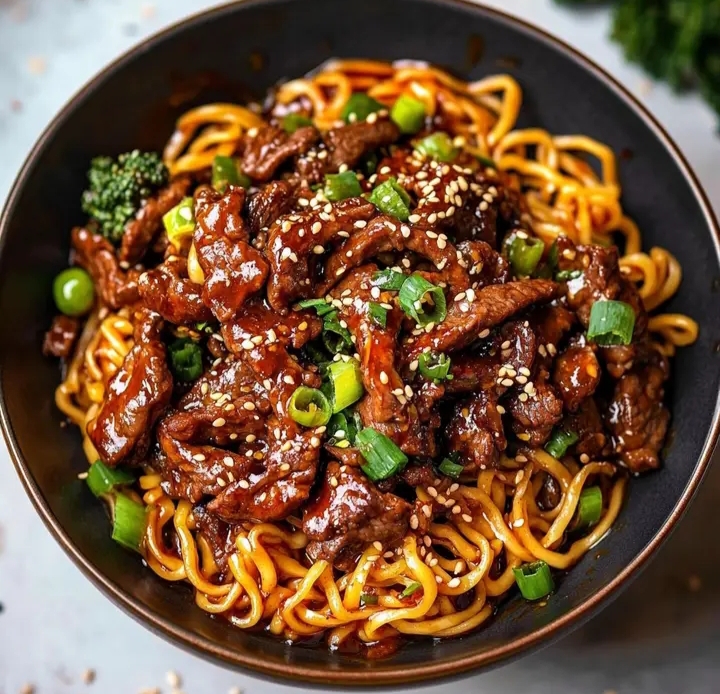There’s something magical about a bowl of **Sticky Beef Noodles**. The first time I made this dish, my kitchen smelled like an Asian street food market—savory, sweet, and just a little spicy. It was love at first bite. My family couldn’t stop raving about how the sauce clung to every noodle, making each forkful (or chopstick-full) an explosion of flavor. Whether you’re new to cooking Asian-inspired dishes or a seasoned pro, this recipe is a must-try. Let’s dive into what makes Sticky Beef Noodles so irresistible.
A Little History Behind Sticky Beef Noodles
While Sticky Beef Noodles may not have a centuries-old backstory, it draws inspiration from classic Asian stir-fries. Think of it as a modern twist on dishes like beef chow mein or pad see ew. These recipes traditionally combine noodles, protein, and veggies in a savory sauce, but the sticky factor here comes from a clever mix of hoisin sauce, soy sauce, and a cornstarch slurry. I remember watching a cooking show where a chef said, “If your sauce doesn’t stick, it’s not doing its job.” That stuck with me—pun intended—and inspired me to perfect this recipe.
Why You’ll Love This Recipe
This dish is a trifecta of awesomeness: quick, easy, and packed with flavor. The combination of tender beef, crisp veggies, and chewy noodles coated in a glossy, sticky sauce is simply irresistible. Plus, it’s versatile enough to suit both weeknight dinners and weekend gatherings. Did I mention it’s ready in just 30 minutes? If you’re looking for a recipe that feels fancy but doesn’t require hours in the kitchen, **Sticky Beef Noodles** is your answer.
Perfect Occasions to Prepare Sticky Beef Noodles
Need a dish to impress friends at a casual dinner party? Or maybe you’re craving something comforting after a long day? Sticky Beef Noodles fit the bill perfectly. They’re also great for busy weeknights when you want something hearty but don’t have much time. I’ve served this dish at potlucks, family reunions, and even impromptu movie nights, and it always disappears fast. Pair it with some spring rolls or dumplings for an extra wow factor.
Ingredients for Sticky Beef Noodles
- For the noodles:
- 250 g of Asian noodles (rice noodles, soba, or egg noodles)
- 300 g of beef, thinly sliced
- 2 tablespoons of vegetable oil
- 2 cloves of garlic, minced
- 1 piece of fresh ginger (2 cm), grated
- 1 carrot, julienned
- 1 red bell pepper, sliced
- 2 green onions, sliced
- For the sticky sauce:
- 3 tablespoons of soy sauce
- 2 tablespoons of hoisin sauce
- 1 tablespoon of oyster sauce (or extra soy sauce for vegetarians)
- 1 tablespoon of honey or brown sugar
- 1 teaspoon of rice vinegar or white vinegar
- ½ teaspoon of ground black pepper
- 1 tablespoon of cornstarch mixed with 2 tablespoons of water
Substitution Options
Feel free to swap ingredients based on what you have on hand. Use chicken, pork, or tofu instead of beef for a different protein. If you’re out of hoisin sauce, a mix of peanut butter and soy sauce works wonders. For veggies, zucchini or snap peas can replace carrots and bell peppers. And if you’re gluten-free, opt for tamari instead of soy sauce and choose gluten-free noodles.
Preparation Steps
Step 1: Cook the Noodles
Start by boiling your noodles according to the package instructions. Keep an eye on them to avoid overcooking—nobody likes mushy noodles! Once they’re al dente, drain and set them aside. Pro tip: Toss the cooked noodles with a splash of sesame oil to prevent sticking.
Step 2: Make the Sticky Sauce
In a small bowl, whisk together soy sauce, hoisin sauce, oyster sauce, honey, vinegar, and black pepper. Add the cornstarch slurry and mix well. This sauce is the star of the show, so taste it before adding it to the pan. Adjust the sweetness or saltiness to your liking.
Step 3: Sear the Beef
Heat a tablespoon of oil in a large skillet or wok over high heat. Add the beef slices and cook for 2–3 minutes until golden brown. Remove the beef and set it aside. The key here is to sear quickly to lock in juices. Don’t overcrowd the pan, or the beef will steam instead of browning.
Step 4: Stir-Fry the Veggies
In the same pan, add another tablespoon of oil. Throw in the garlic, ginger, carrots, and bell pepper. Stir-fry for 2–3 minutes until the veggies are tender-crisp. The aroma of garlic and ginger hitting the hot oil is pure magic!
Step 5: Assemble the Dish
Return the beef to the pan with the veggies. Pour in the sticky sauce and stir everything together. Let it simmer for 1–2 minutes until the sauce thickens and coats the ingredients beautifully. Add the cooked noodles and toss to combine. Watch as the sauce clings to every strand—it’s mesmerizing!
Step 6: Serve and Enjoy
Scoop the noodles into bowls and garnish with sliced green onions. Serve immediately while it’s piping hot. I like to sprinkle some sesame seeds or chili flakes for extra flair. Grab your chopsticks and dig in!
Chef’s Tip
To take this dish to the next level, toast your noodles lightly in a dry pan before boiling them. This adds a subtle nutty flavor that pairs beautifully with the sticky sauce.
Timing Breakdown
- Preparation: 15 minutes
- Cooking: 15 minutes
- Total: 30 minutes
Extra Info
Did you know that hoisin sauce is often called “Chinese BBQ sauce”? It’s sweet, salty, and slightly tangy, making it a staple in many Asian dishes. Its versatility is unmatched—you can use it as a marinade, dipping sauce, or stir-fry enhancer.
Necessary Equipment
- Large skillet or wok
- Pot for boiling noodles
- Wooden spoon or spatula
- Measuring spoons and cups
- Bowls for mixing sauces
Storage Tips
If you have leftovers, store them in an airtight container in the fridge for up to 3 days. Reheat gently in a pan with a splash of water to loosen the sauce. Avoid microwaving, as it can make the noodles soggy.
For meal prep enthusiasts, you can pre-slice the beef and chop the veggies ahead of time. Store them separately in the fridge until you’re ready to cook. This saves precious minutes during busy weekdays.
Freezing isn’t ideal for this dish because the texture of the noodles changes once thawed. But if you must freeze, portion it into individual servings and thaw overnight in the fridge before reheating.
Tips and Advice
- Use a sharp knife to slice the beef thinly against the grain for maximum tenderness.
- Don’t skip the cornstarch slurry—it’s what makes the sauce gloriously sticky.
- Customize the spice level by adding red pepper flakes or sriracha to the sauce.
Presentation Ideas
- Garnish with sesame seeds, chopped cilantro, or crushed peanuts for added texture.
- Serve in shallow bowls with lime wedges on the side for a pop of color.
- Arrange the noodles neatly and drizzle extra sauce on top for a restaurant-worthy look.
Healthier Alternatives
Here are six ways to lighten up this dish:
- Zucchini Noodles: Swap traditional noodles for spiralized zucchini for fewer carbs.
- Tofu Protein: Replace beef with firm tofu for a plant-based option.
- Less Sauce: Reduce the sauce quantity by half to cut down on sodium.
- Steamed Veggies: Steam the vegetables instead of stir-frying to reduce oil usage.
- Whole Grain Noodles: Use whole wheat or brown rice noodles for added fiber.
- No Added Sugar: Omit the honey or brown sugar and rely on the natural sweetness of hoisin sauce.
Common Mistakes to Avoid
Mistake 1: Overcooking the Noodles
Overcooked noodles turn mushy and lose their texture. To avoid this, boil them just until al dente and rinse under cold water to stop the cooking process. Pro tip: Check the package instructions for precise timing.
Mistake 2: Skipping the Cornstarch Slurry
The cornstarch slurry is essential for achieving that sticky consistency. Without it, your sauce will remain thin and watery. Always mix it thoroughly before adding it to the pan.
Mistake 3: Crowding the Pan
When searing the beef, resist the urge to cram all the slices into the pan at once. Doing so lowers the temperature and causes the meat to steam rather than brown. Cook in batches if needed.
FAQ
What type of noodles work best?
Rice noodles, soba, or egg noodles are all excellent choices. Choose based on your preference for texture and flavor.
Can I make this dish vegetarian?
Absolutely! Substitute beef with tofu or tempeh and use additional soy sauce instead of oyster sauce.
How do I thicken the sauce?
The cornstarch slurry is your secret weapon. Mix it well and add it gradually to the sauce while stirring continuously.
Is this dish spicy?
Not inherently, but you can add chili flakes or sriracha if you prefer a kick.
Can I prep this dish in advance?
Yes! Slice the beef and chop the veggies ahead of time. Store them in separate containers in the fridge.
What sides pair well with Sticky Beef Noodles?
Spring rolls, dumplings, or a simple cucumber salad complement this dish beautifully.
How do I reheat leftovers?
Reheat in a pan with a splash of water to revive the sauce. Avoid microwaving to preserve texture.
Can I freeze this dish?
It’s not recommended due to the noodles’ texture change upon thawing.
What’s the best way to slice beef thinly?
Partially freeze the beef for 20–30 minutes before slicing. This firms it up and makes slicing easier.
Why does my sauce taste bland?
Adjust the seasoning! Add more soy sauce for saltiness, honey for sweetness, or vinegar for tanginess.
Final Thoughts
Sticky Beef Noodles are a celebration of bold flavors and textures. Whether you’re cooking for one or feeding a crowd, this dish promises to satisfy. With its sticky, savory goodness and vibrant colors, it’s no wonder this recipe has become a favorite in my household. Give it a try—you might just find yourself making it on repeat!

